Mytchell Ernst
Introduction
Diabetes is a common disease that causes too much sugar to build up in the bloodstream due to the hormone insulin not working correctly or not being present. There are two types, type 1, which is insulin-dependent (meaning the body produces no insulin), and type 2, which is non-insulin-dependent (meaning the body still produces some insulin). Type 2 diabetes is more preventable and common than type 1. Around 32 million people have type 2 diabetes, with about half being women and half being men (American Diabetes Association, 2018; CDC, 2019). This disease can have serious effects on certain parts of the body and can therefore be very dangerous if not taken care of. Although type 2 diabetes is found in men and women at about the same rate, there are certain issues that specifically affect men. Therefore, it is important for males to understand all about type 2 diabetes.
What is Type 2 Diabetes?
Type 2 diabetes is a disease that affects the way the body regulates the fuel known as glucose (also known as blood sugar) (Mayo Clinic Staff, 2021). In the body, the hormone called insulin helps move sugar out of the blood and into either cells or storage. Type 2 diabetes is caused either when cells that take in sugar are unable to respond to insulin as well, or when the body does not create enough insulin. Think of insulin as a key that opens the door to allow sugar to go into cells. If there are not enough keys, then cells will be unable to take in sugar, or if the keyhole is broken, then the key will no longer work as well. This causes there to be too much sugar in the blood, which can damage the body.
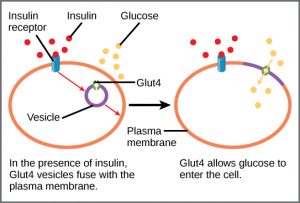
Risk Factors of Type 2 Diabetes
There are many risk factors that can lead to type 2 diabetes, some of which are exclusive to men. Common risk factors identified by the CDC (2019) include: prediabetes, age of 45 years or older, overweight, limited exercise, and having a direct family member with type 2 diabetes. Certain ethnicities are also more at risk for type 2, with African Americans, Hispanic/Latinos, American Indians, and Alaskan Natives at the highest risk, and Asian Americans and Pacific Islanders having a moderate risk (CDC, 2019).
Understanding these risk factors is beneficial in learning how to prevent oneself from getting type 2 diabetes. Diet and exercise are necessary examples of controllable risk factors due to their effects on outcomes of sugar in the blood. Age is an important risk factor because as one ages, insulin doesn’t work as effectively, which can lead to higher blood sugar levels. Family history as well as ethnicity play roles in type 2 due to genetics. Certain ethnicities have specific genes, or traits, as well as practices that make them more likely to get type 2 than those of other ethnicities. If a parent has type 2 diabetes, then their children and grandchildren will have an increased risk of this disease.
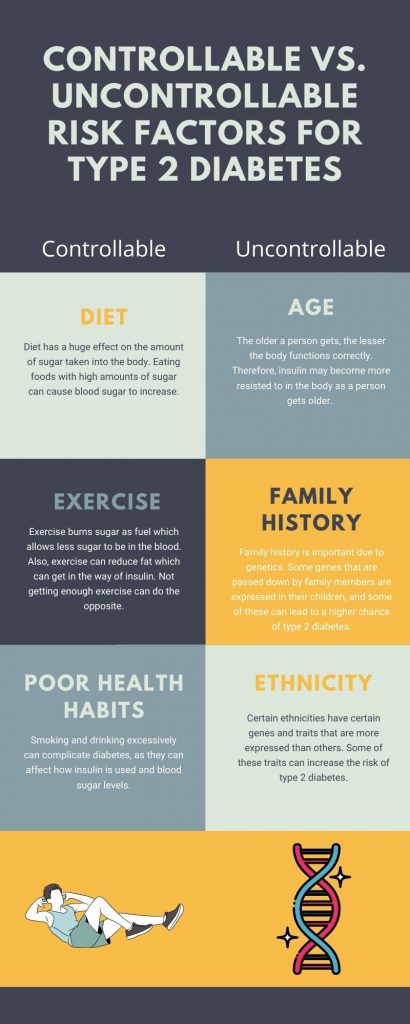
Specific Risk Factors for Men
While most risk factors for type 2 diabetes are shared for men and women, men have some specific issues that could be considered risks for type 2. One specific risk factor is that men who have low levels of testosterone (the primary male hormone) may have a higher risk of getting type 2 (Diabetes.co.uk, 2019). Lower testosterone can result in higher amounts of fat, which can cause more sugar to be in the blood, or more resistance to insulin. Another male risk factor is that men have lower HDL cholesterol levels than women (Mayo Clinic Staff, 2021). HDL cholesterol often protects the body by moving cholesterol from certain body parts to the liver for it to be removed (See Cholesterol chapter for more information). Therefore, since men have lower rates of HDLs than women, they tend to have more cholesterol, and, as a result, have a higher risk of type 2.
Signs and Symptoms
There are many signs and symptoms of type 2 diabetes that can help to determine whether a person has this disease. Common signs and symptoms listed by the Mayo Clinic (2021) include, “…increased thirst, frequent urination, increased hunger, unintended weight loss, fatigue…” and “…blurred vision…”(Mayo Clinic Staff, 2021). They can also include “…slow-healing sores, frequent infection, numbness or tingling in the hands or feet…” and “…areas of darkened skin, usually in the armpits and neck” (Mayo Clinic Staff, 2021).
These signs and symptoms generally result from the high amounts of sugar in the blood, and the low amounts of sugar in the cells caused by insulin resistance. Increased hunger, fatigue, weight loss, and slow healing are common symptoms that occur when cells are not getting the fuel they need. Increased thirst and frequent urination generally are due to too much sugar being in the blood. These signs and symptoms should be shared with a doctor to determine whether a person has type 2 diabetes.
Specified Issues for Men Resulting From Type 2 Diabetes
Men often have various issues that result from type 2 diabetes. One common issue is low testosterone. While low testosterone is often seen as a risk factor for type 2, type 2 can also cause a decrease in testosterone. As described in the Hormone chapter, low testosterone can cause lower energy, depression, a decrease in muscle mass, and a decrease in sex drive (Zahed, 2020). Another issue that men distinctively deal with when they have type 2 diabetes is erectile dysfunction (ED). Having high blood sugar can cause nerve damage, as well as damage to blood vessels, which can affect a male’s ability to get an erection (Zahed, 2020). Medicine that is used to treat type 2 can also cause ED, so talking to a doctor about a certain medicine’s side effects can help prevent this issue (Zahed, 2020). Another issue that men respectively deal with from type 2 diabetes are urinary tract infections (UTI). UTIs result because of nerve damage in the bladder and urinary tract due to having too much sugar in the blood. These can turn very serious if they are not dealt with immediately and can even cause cancers in the bladder and kidneys. Prostate cancer, a type of cancer that is only found in men, is also known to be linked to type 2 diabetes (Prostate Cancer). Some other issues not exclusive to men include increased risk of heart disease, eye damage, amputations of the arms/legs, skin damage, and dementia (Mayo Clinic Staff, 2021). Each of these can be very dangerous and shows why it is important to diagnose and treat type 2.
How to Prevent Type 2 Diabetes
Men should take preventative steps in order to avoid getting type 2 diabetes. Some ways to prevent type 2 include improving diet, exercising, and quitting unhealthy habits such as smoking tobacco. Improving diet can help to balance nutrient intake, which can help the body keep up with breaking down glucose. Exercising can help to lower weight, which is a risk factor for type 2, and can even help get rid of excess sugar by using it as fuel. Quitting unhealthy habits such as smoking tobacco and drinking excessively can reduce the risk of type 2 diabetes, as both of these can complicate this disease.
When and How to Get Treatment
While trying to prevent type 2 diabetes is the best option, sometimes it’s not always possible. Therefore, people who may be at risk for type 2 need to visit a doctor to get their blood sugar levels tested. Some tests require the patient to fast for up to 8 hours before, so contacting the doctor before visiting is advised (US Department of Health, 2017). If the patient is diagnosed with type 2, then they will most likely be referred to an endocrinologist who will explain the disease and give treatment. Depending on how severe the diabetes is, patients will either only change their diet and exercise habits, or will combine it with insulin or other medications. Combining these treatments can help many patients manage and live longer, better lives with type 2 diabetes.

Chapter Review Questions
1. Which of the following does NOT increase the risk of type 2 diabetes?
A. Having a family member with type 2 diabetes
B. Having high levels of HDL cholesterol
C. Smoking tobacco
D. Having low levels of testosterone
2. Type 2 diabetes can cause many different issues to the human body. Of the following, which of these issues caused by type 2 diabetes are male-specific?
A. Erectile dysfunction
B. Increase in testosterone
C. Frequent urination
D. Blurred vision
3. Which of the following is NOT a way to prevent type 2 diabetes?
A. Improving diet
B. Exercising often
C. Taking spironolactone (a medication used to decrease testosterone levels)
D. Quit smoking
References
American Diabetes Association. (2018, March 22). Statistics about diabetes. https://www.diabetes.org/resources/statistics/statistics-about-diabetes
Centers for Disease Control and Prevention. (2019, May 30). Diabetes basics. https://www.cdc.gov/diabetes/basics/index.html
Dansinger, M. (2019, July 1). Type 2 diabetes treatments. WebMD. https://www.webmd.com/diabetes/type-2-diabetes-treatments.
Diabetes.co.uk. (2020, March 6). Testosterone and diabetes. Diabetes Digital Media. https://www.diabetes.co.uk/body/testosterone-and-diabetes.html#:~:text=Research%20has%20shown%20that%20low,visceral%20fat%20storage%20in%20women
Mayo Clinic Staff. (2021, January 20). Type 2 diabetes. Mayo Clinic. https://www.mayoclinic.org/diseases-conditions/type-2-diabetes/symptoms-causes/syc-20351193
U.S. Department of Health and Human Services. (2017, May 1). Type 2 diabetes. National Institute of Diabetes and Digestive and Kidney Diseases. https://www.niddk.nih.gov/health-information/diabetes/overview/what-is-diabetes/type-2-diabetes
Zahed, R. (2020, November 11). How type 2 diabetes affects men. Keck Medicine of USC. https://www.keckmedicine.org/how-type-2-diabetes-affects-men/
rate of occurrence or influence
Structure and Function
Colorectal cancer, or CRC, is a form of cancer that begins in the colon or the rectum (American Cancer Society [ACS], 2020f). These are two different types of cancer but are grouped since they have similar traits. The colon and rectum make up the large intestine. The large intestine and the small intestine play a large role in the human digestive system. Most of the large intestine is the colon which has four parts: ascending, transverse, descending, and sigmoid colon. The sigmoid colon connects to the rectum and allows for waste disposal by the anus (ACS, 2020f).
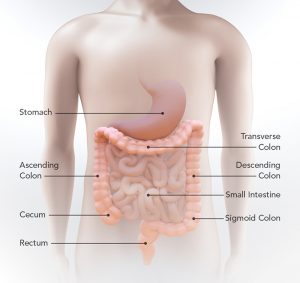
The colon’s job is to soak up water and salt from the undigested food of the small intestine (ACS, 2020f). The remaining waste travels through the colon and into the rectum. The waste stays in the rectum until it leaves the body through a bowel movement. The colon plays an important role in food digestion, yet the formation of cancer makes it difficult for the colon and rectum to do their job (ACS, 2020f).
Colorectal cancer typically begins as a growth on the inner lining of the colon or rectum (ACS, 2020f). The growths are known as polyps and can be cancerous based on the type. Some polyps change into cancer over time, while other polyps remain cancer-free. Cancer risk increases if a polyp is larger than 1 cm, if more than three polyps exist, or if dysplasia remains after polyp removal (ACS, 2020f). If a polyp is cancerous, cancer will begin to grow at the mucosal layer of the colon. Depending on the cancer type, the polyp will stay inside the colon or spread to other organs by the bloodstream or lymphatic system. The extent of colorectal cancer depends on how deeply it grows in the body tissues and how far it spreads (ACS, 2020f).
Risk Factors
Colorectal cancer is the third leading cause of cancer mortality in the U.S. and is the third most common type of cancer for men and women (Centers for Disease Control and Prevention [CDC], 2020). Although colorectal cancer shares the same ranking for men and women, this type of cancer is more common among men. Compared to women, men have more cases of CRC and larger death rates. According to White et al. (2018), men are at a greater risk for colorectal cancer due to gender-related behavior like diets high in red meat or fat, increased alcohol use, and smoking compared to women. Other risk factors include a family history of colorectal cancer, irritable bowel syndrome, race and ethnicity, and age (ACS, 2020c).
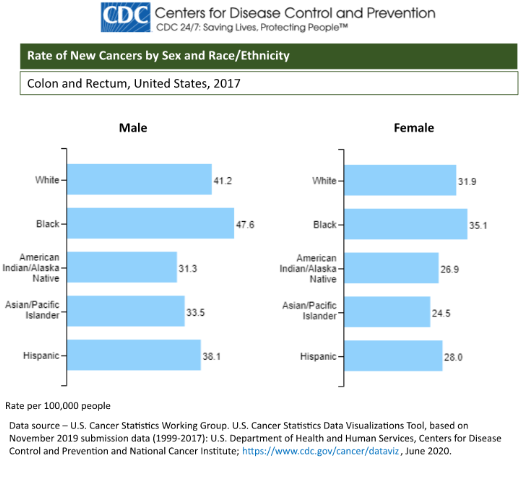
Prevention
There are currently two prevention strategies for CRC: primary and secondary prevention. Around 70% of CRC cases, in theory, are due to lifestyle factors like diet, level of physical activity, and location of fat as mentioned in the abdominal obesity chapter (Roncucci & Mariani, 2015). The target of primary prevention is the general population, specifically people who are at risk due to their lifestyle. The recommendation at the population level is to be physically active every day, be within a normal BMI range, limit red meat intake, eat a variety of fiber-rich food, and avoid alcohol use or smoking (Roncucci & Mariani, 2015). A lifelong healthy lifestyle is important for CRC prevention.
Secondary prevention focuses on people at an average or higher risk for CRC due to age, family history of colorectal syndromes, and people with irritable bowel syndrome (Roncucci & Mariani, 2015). The goal of secondary prevention is to catch CRC cancer early to improve the chances of survival. It is important that adults older than 45 should have regular CRC screening through national programs. People who carry the gene for CRC have a higher risk of developing cancer during their lifetime and should get a colonoscopy every one to two years starting at ages 20-25. In addition, people with irritable bowel syndrome should begin to have colonoscopies 10 years after diagnosis to monitor abnormal cell growth. In conclusion, living a healthy lifestyle and regular screening are the recommended prevention strategies for CRC (Roncucci & Mariani, 2015).
Symptoms of Colorectal Cancer
The American Cancer Society (2020b) states that the early stages of colorectal cancer often show no symptoms, highlighting the importance of regular screening for cancer detection and survival. Although most CRC cases are found in adults 55 years old or older, the number of cases is steadily rising in young adults. For example, in 2020, an estimated 17,930 adults under 50 were diagnosed with colorectal cancer, which is equal to 49 new cases each day. Common digestive symptoms are rectal bleeding, blood in the stool or the toilet after a bowel movement, black stool, or frequent constipation and diarrhea. Other symptoms include cramping or pain in the lower stomach, accidental weight loss, and decreased appetite. If any of these symptoms are present, it is necessary to contact a physician to figure out the cause. Therefore, if any of these symptoms are present it is crucial to seek medical attention for the overall survival of CRC.
Screening Options
In 2018, the American Cancer Society (2020b) lowered the recommended screening age from 50 to 45 due to CRC cases increasing in younger populations. Colorectal cancer can be diagnosed by sensitive stool-based tests or visual exams of the colon and rectum. Patients should discuss each test type with their doctor to select the best option based on their health. The ability for patients to choose from a variety of screening tests has substantially increased regular screening among the population. The American Cancer Society does not favor a single test type and promotes several screening options to encourage everyone to get tested.
The American Cancer Society (2020d) recommends two types of stool-based tests called the high-sensitivity guaiac fecal occult blood test (gFOTB) and the fecal immunochemical test (FIT). As the stool exits the rectum, friction with cancer polyps can cause blood to appear in feces. Both tests examine the stool for hidden blood and require completion each year. The gFOTB and FIT screenings occur at home through a collection kit service, and the sample is sent to the lab for analysis. The main difference between the test types is that the gFOTB requires dietary restrictions before sample collection. People who select this test should avoid vitamin c, NSAIDs, and red meat a week before collection for accurate results. In comparison to other screening options, stool-based tests do not require a doctor's visit, low cost, and a less invasive approach (ACS, 2020d). The regular use of the gFOTB led to a 20% decrease in CRC formation and a 32% decrease in CRC death (ACS, 2020b).
Visual screening techniques for CRC include colonoscopy, flexible sigmoidoscopy, and computed tomography colonography (ACS, 2020b). Doctors can view the inner lining of the colon and rectum by using an endoscope or x-ray imaging. The endoscopic techniques are colonoscopy and flexible sigmoidoscopy. An endoscope is inserted into the anus, rectum, and colon to search for polyps. (ACS, 2020b). The major difference between the tests is that the sigmoidoscopy device can only visualize one-third of the colon, but the colonoscopy device can display the entire colon. The testing recommendation for colonoscopy is every ten years and every five years for a sigmoidoscopy. According to the American Cancer Society (2020b), a colonoscopy reduces CRC occurrence by 40% and cancer death by 60%. A sigmoidoscopy reduces CRC onset by 20-25% and cancer death by 25-30%. The use of sigmoidoscopy led to a greater reduction in CRC death in men than women, so this is important to consider when choosing a screening method. A computed tomographic colonography builds 3D images of the colon from x-rays. This method takes place every five years and offers a less-invasive option for patients. (ACS, 2020b). Regardless of the test type, screening plays a key role in colorectal cancer detection and potential treatment options (Lauby-Secretan et al., 2018).

Treatment
Treatment for colorectal cancer depends on the cancer stage when diagnosed and location. The American Cancer Society (2020e) describes common treatment options like surgery, chemotherapy, and radiation. Surgery is the main treatment option for colon and rectal cancers that have not metastasized. (ACS, 2020e). Most early-stage colon and rectal cancers are removed during a colonoscopy to avoid major surgery. A polypectomy removes cancer by cutting the polyp off the inner lining, while a local excision removes the polyp and surrounding healthy tissue (ACS, 2020e). If cancer has metastasized, treatment involves a combination of surgery, chemotherapy, and radiation. The goal of chemotherapy and radiation is to shrink tumors to a smaller size for surgical removal. When cancer has spread beyond the possibility of removal, chemotherapy becomes the primary course of treatment for colon and rectal cancers (ACS, 2020e).
Early diagnosis and treatment of colorectal cancer result in a 90% survival rate for the next five years (ACS, 2021a). In comparison, when colorectal cancer is found in the later stages, the five-year survival rate for rectal cancer is 16% and 14% for colon cancer (ACS, 2021a). Regular screening is essential for the early detection and treatment of colorectal cancer. Currently, only 38% of colorectal cancers are caught in the early stages, partly due to lack of screening. (ACS, 2021a). Increasing awareness of the variety of screening techniques and risk factors can improve screening habits and overall survival of CRC (ACS, 2020b).
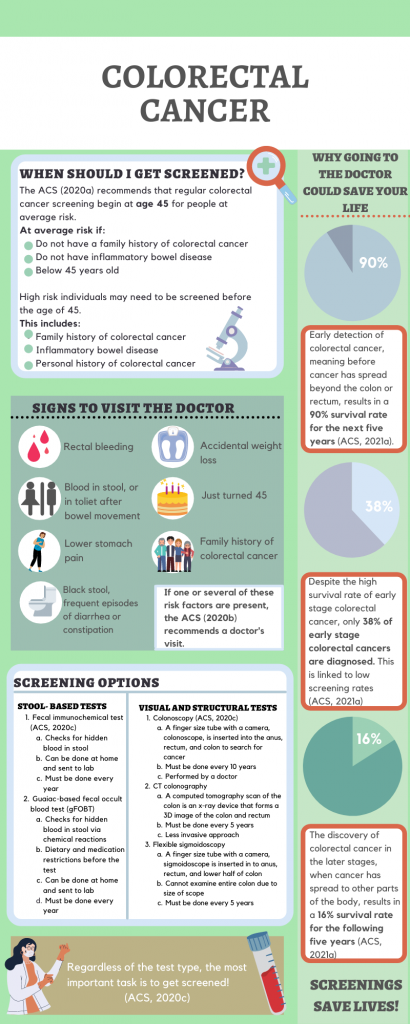
Chapter Review Questions
1. Men are at a greater risk for colorectal cancer development due to all of the following behaviors except?
A. Diets high in red meat
B. Alcohol consumption
C. Poor sleeping habits
D. Smoking
2. What is a symptom of early-stage colorectal cancer?
A. No obvious symptoms
B. Black stool
C. Rectal bleeding
D. Abdominal cramping
3. At what age does the American Cancer society recommend colorectal cancer screening?
A. 50
B. 35
C. 45
D. 60
References
American Cancer Society. (2020a, November 17). American Cancer Society guideline for colorectal cancer screening. https://www.cancer.org/cancer/colon-rectal-cancer/detection-diagnosis-staging/acs-recommendations.html
American Cancer Society (2020b). Colorectal cancer facts & figures 2020-2022. https://www.cancer.org/content/dam/cancer-org/research/cancer-facts-and-statistics/colorectal-cancer-facts-and-figures/colorectal-cancer-facts-and-figures-2020-2022.pdf
American Cancer Society. (2020c, June 29). Colorectal cancer risk factors. https://www.cancer.org/cancer/colon-rectal-cancer/causes-risks-prevention/risk-factors.html
American Cancer Society. (2020d, June 29). Colorectal cancer screening tests. https://www.cancer.org/cancer/colon-rectal-cancer/detection-diagnosis-staging/screening-tests-used.html
American Cancer Society. (2020e, June 29). Colorectal cancer treatment | How to treat colorectal cancer. https://www.cancer.org/cancer/colon-rectal-cancer/treating.htm
American Cancer Society. (2021a). Survival rates for colorectal cancer. https://www.cancer.org/cancer/colon-rectal-cancer/detection-diagnosis-staging/survival-rates.html
American Cancer Society. (2021b). Text alternative for colon & rectal cancer: Catching it early. https://www.cancer.org/cancer/colon-rectal-cancer/prevention-infographic/text-alternative-for-colon-and-rectal-cancer-catching-it-early.html
American Cancer Society. (2020f, June 29). What is colorectal cancer? https://www.cancer.org/cancer/colon-rectal-cancer/about/what-is-colorectal-cancer.html
Centers for Disease Control and Prevention. (2020, June 8th). Colorectal cancer statistics. https://www.cdc.gov/cancer/colorectal/statistics/index.htm
Lauby-Secretan, B., Vilahur, N., Bianchini, F., Guha, N., & Straif, K. (2018). The IARC perspective on colorectal cancer screening. New England Journal of Medicine, 378(18), 1734-1740. 10.1056/NEJMsr1714643
Roncucci, L. and Mariani, F. (2015). Prevention of colorectal cancer: how many tools do we have in our basket? European Journal of Internal Medicine, 26 (10), 752-756. 10.1016/j.ejim.2015.08.019
White, A., Ironmonger, L., Steele, R. J. C., Ormiston-Smith, N., Crawford, C., & Seims, A. (2018). A review of sex-related differences in colorectal cancer incidence, screening uptake, routes to diagnosis, cancer stage, and survival in the UK. BMC Cancer, 18(1), 906. 10.1186/s12885-018-4786-7.
Introduction
Lung cancer is a form of cancer that begins in the lungs. The lungs are spongy organs that take in oxygen and release carbon dioxide (Mayo Clinic, 2020). When humans inhale, oxygen is taken into the bloodstream where it is carried throughout the body and is traded for carbon dioxide which is a waste gas that is released when exhaled. There is a right lung and a left lung that are divided into segments called lobes. Once air enters into the lungs, it travels down branches that decrease in size starting with the bronchus and the end is the alveoli.
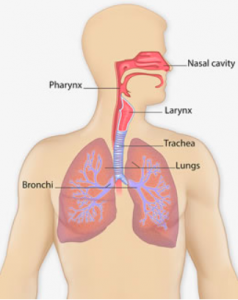
The alveoli are tiny air sacs where oxygen is exchanged for carbon dioxide (American Lung Association, 2020). The lungs are very important to the human body as they help humans breathe, but the presence of lung cancer makes it very difficult for the lungs to work properly.
Symptoms and Diagnosis
Most people with lung cancer do not show symptoms in the early stages but as the cancer advances, symptoms start to appear. They may seem small at first such as a cough that won’t go away, headaches, loss of voice, and fatigue (CDC, 2020). More extreme symptoms are chest pain, coughing up blood, shortness of breath, unintended weight loss, seizures, and vomiting (CDC, 2020). When diagnosing patients, there are two different types of lung cancer; small cell lung cancer (SCLC) and non-small cell lung cancer (NSCLC). Non-small cell lung cancer is further divided into adenocarcinoma, squamous cell carcinoma, and large cell carcinoma (Collins et al., 2007). Non-small cell lung cancers account for 85% of lung cancer with small cell lung cancers accounting for 15% of lung cancers (Collins et al., 2007). Specifically, adenocarcinoma is the most common type of lung cancer compromising 38.5% of all lung cancers (Collins et al., 2007). The different lung cancer categories help doctors during diagnosis and treatment (Dela Cruz et al., 2011). African American men are the most susceptible to lung cancer compared to other ethnicities as the age-adjusted rate is 32% higher (Ryan, 2018). Hispanic men have the lowest incidence followed by American Indian/Alaska Native then Non-Hispanic White and African American men with the highest incidence (Ryan, 2018).
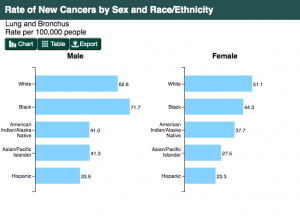
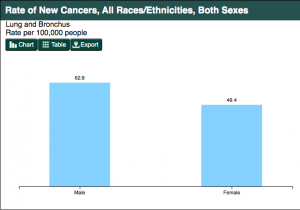
How Smoking Leads to Lung Cancer
Lung cancer is the most deadly form of cancer as the average five-year survival rate is around 15 percent (Collins et al., 2007). There are equal amounts of Americans that die of lung cancer compared to prostate, breast, and colon cancer combined (Collins et al., 2007). The most common cause of lung cancer is smoking as about 80-90% of lung cancer deaths are linked to cigarette smoking. This is mainly due to the fact that there are 70 known carcinogens in tobacco smoke. According to the Center for Disease Control and Prevention (2020), “people who smoke cigarettes are 15 to 30 times more likely to get lung cancer or die from lung cancer than people who do not smoke”. Men are especially at risk as they begin to smoke at an earlier age and for a longer duration than women (Visbal et al., 2004). Breathing in secondhand smoke from other people’s tobacco smoke also increases one’s risk for lung cancer. Occupational hazards such as radon, asbestos, arsenic, and diesel exhaust exposure increase one’s risk for lung cancer (CDC, 2020). These are common chemicals found in everyday activities such as cars, trucks, and houses that contain carcinogens which can lead to the formation of cancer when inhaled.
According to Collins et al. (2007), “the most important step in preventing lung cancer is smoking cessation”. Quitting smoking and prevention strategies have proven to be the most effective in decreasing lung cancer (Dela Cruz et al., 2011). The most effective types of quitting smoking treatments are nicotine replacement, counseling, social support, and other medications. Limiting any exposure to smoking such as never smoking, quitting, and avoiding secondhand smoke is very important to preventing lung cancer. Another preventative step is to take precautions to protect oneself from exposure to toxic chemicals at work and home such as asbestos and radon (American Lung Association, 2020).
Screening
Lung cancer screening remains a much debated topic as it has yet to prove that it decreases lung cancer deaths. Lung cancer screening has led to overdiagnosis, unnecessary anxiety, and high costs. There is not enough evidence to prove its overall effectiveness but it has shown to find early cases of lung cancer (Collins et al., 2007). The current guidelines for screening as supported by the U.S. Preventative Services Task Force (USPSTF) is annual low dose CT scans for patients aged 55 to 80 years old and with a 30 pack-year history (have smoked a pack of cigarettes a day for 30 years) or who have quit within the past 15 years (Latimer & Mott, 2015). The reason for the debate stems from the lack of knowledge regarding the long-term hazards from cumulative radiation exposure. There is a risk to be taken during the screening process and often times if lung cancer is found, it is difficult to treat. Due to the differences in guidelines and opinions, conversations with physicians and other health care workers must be had before considering lung cancer screening (Latimer & Mott, 2015).
Treatment
Treatment of lung cancer depends on the type of cancer, stage, and patient history. Overall staging of lung cancer is dependent upon the size of the tumor found and if it has spread to other organ systems. The smaller the tumor and less spread to other organs are reflected in a lower stage. Stage I is the lowest and stage IV is the highest and most severe. Stages I-III are considered local stages while stage IV and some aspects of stage III are considered advanced (Collins et al., 2007). The three most common types of lung cancer treatment consist of surgery, chemotherapy, and radiation therapy. Surgery is the primary treatment for patients with earlier stage lung cancer (stages I-III). Often times surgery will be followed up with rounds of chemotherapy and radiation based upon the progression of the cancer. For small cell lung cancer, chemotherapy and radiation are the most recommended treatments. For non small-cell lung cancer, minimally invasive surgery is recommended with chemotherapy and radiation to follow if needed. For the best outcome, a team of specialists including but not limited to a medical oncologist, radiation oncologist, pathologist, radiologist, and thoracic surgeon must be consulted related to lung cancer (Latimer & Mott, 2015).

Chapter Review Questions
1. What ethnicity is most susceptible to lung cancer compared to other ethnicities?
A. Hispanic
B. White
C. African American
D. American Indian/Alaska Native
2. Which of the following smoking cessation treatments has been found to be least effective?
A. Nicotine Replacement
B. Cold Turkey
C. Counseling and Social Support
D. Medication
3. What is the most common type of lung cancer?
A. Adenocarcinoma
B. Squamous Cell Carcinoma
C. Small Cell Lung Cancer
D. Large Cell Carcinoma
References
American Lung Association. (2020, April 2). How lungs work. https://www.lung.org/lung-health-diseases/how-lungs-work
Centers for Disease Control and Prevention. (2020, September 22). Lung cancer: what are the risk factors. https://www.cdc.gov/cancer/lung/basic_info/risk_factors.htm
Collins, L. G., Haines, C., Perkel, R., & Enck, R. E. (2007). Lung cancer: diagnosis and management. American Family Physician, 75(1), 56–63. Retrieved from https://www.aafp.org/afp/2007/0101/p56.html
Dela Cruz, C. S., Tanoue, L. T., & Matthay, R. A. (2011). Lung cancer: epidemiology, etiology, and prevention. Clinics in Chest Medicine, 32(4), 605–644. https://doi.org/10.1016/j.ccm.2011.09.001
Latimer, K. M., & Mott, T. F. (2015). Lung cancer: diagnosis, treatment principles, and screening. American Family Physician, 91(4), 250-256. Retrieved from https://www.aafp.org/afp/2015/0215/p250.html
Mayo Clinic. (2020, October 10). Lung cancer. https://www.mayoclinic.org/diseases-conditions/lung-cancer/symptoms-causes/syc-20374620
Ryan B. M. (2018). Lung cancer health disparities. Carcinogenesis, 39(6), 741–751. https://doi.org/10.1093/carcin/bgy047
Visbal, A. L., Williams, B. A., Nichols III, F. C., Marks, R. S., Jett, J. R., Aubry, M. C., Edell, E. S., Wampfler, J. A., Molina, J. R., & Yang, P. (2004). Gender differences in non–small-cell lung cancer survival: an analysis of 4,618 patients diagnosed between 1997 and 2002. The Annals of Thoracic Surgery, 78(1), 209-215. http://doi.org/10.1016/j.athoracsur.2004.01.010

